Microcharacterisation Facility
Qualitative and quantitative analysis of materials using state-of-the-art instrumentation including JEOL Hyperprobe, iTrax Core Scanner, XRF and XRD.
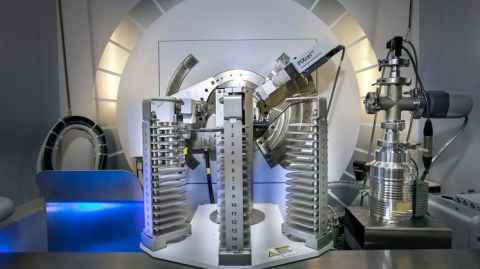
Equipment
- Rigaku XtaLAB Synergy-S single crystal X-ray diffractometer with dual Cu/Ag Kα source (XRD)
- PANalytical Empyrean powder X-ray diffractometer with Cu Kα source (XRD)
- JEOL Field Emission Electron Probe Microanalyser System 8530F (Hyperprobe)
- Cox Analytical iTrax Core Scanner
- Bruker S8 TIGER (Series 2) WDXRF (4KW).
- Inductively Coupled Plasma Mass Spectrometry (ICP-MS)
- With Laser Ablation (LA-ICP-MS)
Rigaku XtaLAB Synergy-S Single Crystal X-ray Diffractometer
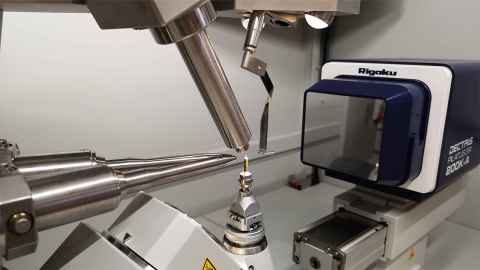
X-ray Diffraction is a non-destructive analytical technique that provides detailed information about the internal lattice of crystalline substances.
Our XtaLAB Synergy-S single crystal diffractometer is equipped with:
- Cu and Ag Kα X-ray sources, providing data collection to an accuracy of up to 0.80 or 0.35 Å, respectively
- Pilatus 200K hybrid photon detector
- Oxford Cryostream, which allows measurement temperatures from 90 K to room temperature under a mixed dry air/nitrogen flow.
Our service includes:
- Data collection and structure determination
- Single-crystal X-ray diffraction measurements for precise determination of a unit cell, including cell dimensions and positions of atoms within the lattice. Bond-lengths and angles are directly related to the atomic positions.
Sample requirements:
- Suitable for small molecule crystals or extended structures, with small protein crystals being possible
- Optimum sample is an untwinned crystal with a size of 50-150 microns, with smaller sizes possible
- Oxygen/moisture sensitive samples are possible
- Power diffraction is possible on special request if you have insufficient sample to use the powder diffractometer.
PANalytical Empyrean Powder X-ray Diffractometer
Our PANalytical Empyrean diffractometer is equipped with:
- Cu Kα X-ray source
- PIXcel 1D detector
- Add-on modules allowing high temperature measurements up to 1000°C as well as X-ray reflectivity measurements for thin films.
Please note: This is a self-use instrument that requires safety training before access can be given. Contact the X-ray technician at the bottom of this page to request training.
Instrument capabilities:
- Powder X-ray diffraction for phase identification of materials including minerals and Rietveld refinement for crystal structure determination
- Crystallinity measurement
- Clay minerals or 3 stage XRD scan - i) air dried, preferred orientation ii) glycolated and iii) heat treated samples
- XRD for non-ambient, high-temperature phase shift measurements - the collection of data up to 1000°C
- X-ray reflectivity for thin films
- Adjustable XYZ sample stage for diffraction measurements of irregularly shaped samples up to 100 mm x 100 mm x 100 mm in size with a weight limit 1 kg.
Sample requirements:
- Approximately 1g of sample is normally required, however, samples as small as 50 mg can be possible using a Si-based zero background holder
- Ambient sample conditions, therefore oxygen/moisture sensitive samples would need special sample preparation by the user.
JEOL Field Emission Electron Probe Microanalyser System 8530F (Hyperprobe)
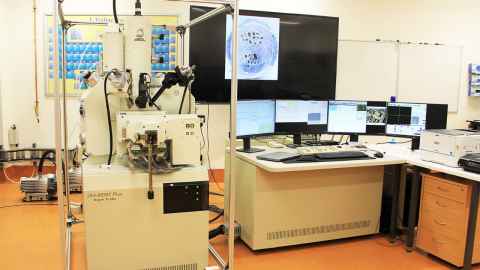
This microanalysis system focuses a narrow collimated beam of electrons onto a solid sample to quantify its major and trace element chemistry. It can characterise chemical contrasts across zones of only tens of nanometres – the highest resolution technique available for this purpose.
This capability is especially suited to micro-geochemical studies within natural minerals, as well as manufactured surfaces, coatings, bone and ceramics.
The “Field-Emission Electron Microprobe Analyser FE-EMPA” is an advance on EPMA technology that uses high-vacuum, precision beam focusing and more reliable energy sources to produce a collimated beam of electrons at only nanometres in diameter. This opens the door to a level of non-destructive spot and spatial analysis of solid materials at scales not previously possible.
In addition, new large-area detection systems are used to detect elements formerly unseen at edges of the X-Ray detection spectrum as well as to provide better determination of trace-elemental compositions. Other enhancements to the technology enable high-speed quantitative 2D chemical mapping of samples. This has turned FE-EMPA into a one-stop shop for the finest-possible spot analysis.
Cox Analytical iTrax Core Scanner
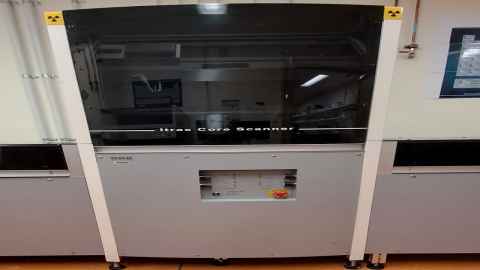
The iTrax Core Scanner is a distinctive laboratory analytical instrument that performs non-destructive X-ray density and elemental analysis on a wide range of solid samples. Its primary application is to assess high-resolution environmental and chemical features of sediment and rock cores in hours to days.
It is widely used in various fields, including geology, paleoclimatology, environmental science and archaeology. It offers a powerful and versatile tool for studying sedimentary records, reconstructing past environmental changes and understanding Earth's history.
Bruker S8 Tiger (Series 2) Wavelength Dispersive X-ray Fluorescence instrument
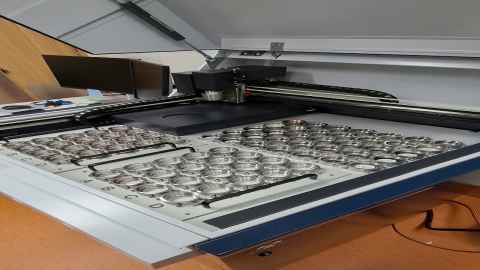
The S8 Tiger is a fully automated computer controlled sequential wavelength dispersive X-ray fluorescence (WDXRF) spectrometer used for high precision, qualitative, quantitative and semi-quantitative element analysis in a variety of applications. The spectrometer can assess elements with Z values ranging from 6 (Carbon) to 92 (Uranium) in concentrations ranging from PPM to 100% in liquid, solid, bead or powder samples. It is used for normal and non-routine element analysis of a wide range of goods such as ferrous and non-ferrous alloys, slags, ores and minerals, glasses, powders, solutions in the geological, biological, forensic, food and environmental fields. It is equipped with a 4 KW Rh anode X-ray tube, as well as proportional flow counter and Scintillation counter detectors.
Sample Requirements:
- (8-10) grams of fine grounded powder (< 100 mesh size)
- Spherical/circular metal piece of diameter 18 mm, 28 mm, 34 mm, and 40 mm.
Our service includes:
- Preparation and elemental analysis of fused glass discs. Automated sample disc fusion and programmable fusion settings to optimise the preparation of the sample discs
- Preparation and elemental analysis of pressed powders pellets, loose powder method, fired pressed pellet with aluminium cup backing and self-supporting pellet method
- XRF instrument operates in continuous measurement mode reducing sample turnaround times
- S8 Tiger WDXRF is equipped with user-friendly software that allows for easy instrument control, data analysis, and reporting. The software provides tools for calibration, quantification, and advanced data processing.
Portable X-ray fluorescence (pXRF) instrument
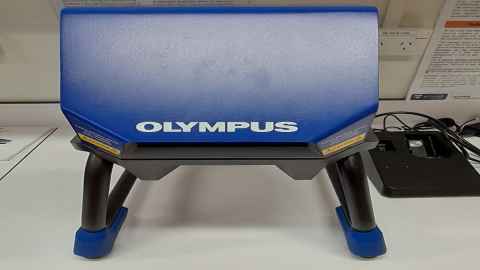
Our portable, handheld X-ray fluorescence analyser is designed to be carried wherever testing is required because it is durable. A variety of materials can be quickly and accurately analysed for their elements and alloy composition using a pXRF analyser. Our handheld pXRF analyser aids in helping you choose the right course of action while on the go by providing results you can rely on. The VantaTM handheld pXRF analyser M series is one of our newest and most potent handheld XRF devices. It provides quick, accurate element analysis for customers who require laboratory-quality findings on the go. Powerful XRF equipment, like our pXRF analysers, can measure the elemental composition at any concentration, from ppm to 100%, for elements with atomic numbers ranging from Z = 11 (sodium) to Z = 92 (uranium). It is used across a range of industries for purposes such as scrap recycling, positive material identification (PMI), compliance screening, mining, geochemistry, environmental assessments, and precious metal testing.
TESCAN CLARA Ultra-High-Resolution Field-Emission Gun Scanning Electron Microscope (UHR-FEG-SEM)
The Field-Emission Gun Scanning Electron Microscope (FEG-SEM) uses a highly focused electron beam that can be static or scanned across a specimen to produce very high-resolution topological and relative-composition, Cathodoluminescence and, in some cases, crystalline structural images. The focused electron beam also generates characteristic X-rays that can be detected to produce qualitative and quantitative chemical analysis, and X-ray distribution maps of prepared specimens.
This instrument is suitable for a wide range of materials including biological, geological, environmental, material science, nano material, industrial specimens, and many others. The FEG-SEM in this facility is capable of both high-vacuum and low vacuum analysis to accommodate a wide range of sample types including insulating samples, samples which cannot be coated with conductive material, and samples sensitive to high-vacuum environment.
Capabilities:
- Secondary Electron Imaging (SE)
- Backscattered Electron Imaging (BSE)
o Angular Filtering
o Energy Filtering - Electron Backscatter Diffraction (EBSD)
o Forescattered Electron Imaging - Panchromatic Cathodoluminescence (CL)
- Energy Dispersive X-ray Analysis (EDS)
o Qualitative
o Quantitative
o X-ray Maps
o Beryllium to Americium - Large-area Mapping
- Feature Sizing
- Low-vacuum Imaging
- Large
Specifications:
- Landing energy: 50ev – 30keV
- Beam current: 2pA – 400nA
- Electron Beam Resolution: 0.9nm
- Variable Pressure Vacuum: 500 Pa – <9x103 Pa
- EDS: 65mm2 active area SDD BSE Detector
- EBSD: 600 patterns per second
- Chamber mounted plasma cleaning
Inductively Coupled Plasma Mass Spectrometry (ICP-MS)
The University of Auckland operates an Agilent 7700 ICP-MS that can be coupled to our deep-ultraviolet (193 nm) New Wave Excimer laser ablation system or LC-MS (for compound-specific elemental analysis).
The ICP-MS is equipped with collision cell technology (He) for reduction and elimination of spectral interferences on difficult to analyse elements.
Inductively Coupled Plasma Mass Spectrometry (ICP-MS) is a technique suitable for elemental analysis of a wide range of inorganic and organic materials, including geological, biological, medical, agricultural and environmental samples.
Its main advantage is that it can analyse a large number of elements in a single analytical run. Samples can be analysed in either a liquid (solution ICP-MS) or solid form (laser ablation ICP-MS) with typical detection limits in the (sub)parts per trillion (solutions) or parts per billion range (solids).
In addition to elemental analysis, the ICP-MS can be used for the determination of isotopic ratios of selected elements to a precision of ±0.2% for isotopic tracing and uranium-lead dating of minerals from rocks such as zircon.
Elements that can be analysed by ICP-MS include: Li, Be, B, Na, Mg, Al, Si, P, Ca, Sc, Ti, V, Cr, Mn, Fe, Co, Ni, Cu, Zn, Ga, Ge, As, Se, Rb, Sr, Y, Zr, Nb, Mo, Ru, Rh, Pd, Ag, Cd, In, Sn, Sb, Te, Cs, Ba, rare earth elements (actinides), Hf, Ta, W, Os, Re, Ir, Pt, Au, Hg, Tl, Pb, Bi, Th and U.
Our services include:
- Sample preparation including mounting of solids for laser ablation ICP-MS and digestion of samples for solution ICP-MS analysis
- Elemental analysis of a wide range of sample types either by laser ablation or solution ICP-MS
We have previously developed and applied methods that include:
- rocks and glasses in volcanic systems
- geochronology of minerals
- micro-fossil records of paleoclimatology and oceanography
- meteorites and the origins of the Solar System
- kai moana (paua, cockles, mussels) and aquaculture
- fish otoliths and life histories
- plant and wood material
- animal/human teeth and migration
- provenancing of archaeological artefacts
- anti-cancer drugs
How we can help you
Bookings to use our equipment can be made through iLab or the relevant technician. We are also able to provide training to use the equipment requested.
Our people
Technical contacts
- XRD: Dr Timothy Christopher
- XRF and iTrax: Dr Harpreet Singh Kainth
- Microprobe: David Adams
- ICP-MS: Stuart Morrow
Other contacts
- Technical Operator: TBC
- Technical Manager: Michael Wadsworth
- Technical Manager: Blair Sowman
- Academic Lead XRD: Professor Tilo Söhnel
- Academic Lead EPMA: Professor Shane Cronin
- Academic Lead ICP-MS and LA-ICP-MS: Dr Michael Rowe
- Academic Lead XRF: Associate Professor Phil Shane
- Academic Lead iTrax: Associate Professor Paul Augustinus